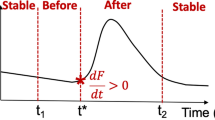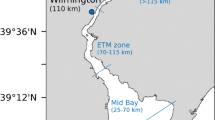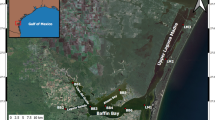Abstract
The Swan River estuary, Western Australia, has undergone substantial hydrological modifications since pre-European settlement. Land clearing has increased discharge from some major tributaries roughly 5-fold, while weirs and reservoirs for water supply have mitigated this increase and reduced the duration of discharge to the estuary. Nutrient loads have increased disproportionately with flow and are now approximately 20-times higher than pre-European levels. We explore the individual and collective impacts of these hydrological changes on the Swan River estuary using a coupled hydrodynamic-ecological numerical model. The simulation results indicate that despite increased hydraulic flushing and reduced residence times, increases in nutrient loads are the dominant perturbation producing increases in the incidence and peak biomass of blooms of both estuarine and freshwater phytoplankton. Changes in salinity associated with altered seasonal freshwater discharge have a limited impact on phytoplankton dynamics.
Similar content being viewed by others
Literature Cited
Chan, T. U. andD. P. Hamilton. 2001. The effect of freshwater flow on the succession and biomass of phytoplankton in a seasonal estuary.Marine and Freshwater Research 52:869–884.
Cloern, J. E. 2001. Our evolving conceptual model of the coastal eutrophication problem.Marine Ecology Progress Series 210: 223–253.
Cooper, S. R. andG. S. Brush. 1993. A 2,500-year history of anoxia and eutrophication in Chesapeake Bay.Estuaries 16: 617–626.
Davies, P. E. andS. R. Kalish. 1994. Influence of river hydrology on the dynamics and water quality of the upper Derwent estuary, Tasmania.Australian Journal of Marine and Freshwater Research 45:109–130.
Donohue, R., W. A. Davidson, N. E. Peters, S. Nelson, andB. Jakowyna. 2001. Trends in total phosphorus and total nitrogen concentrations of tributaries to the Swan-Canning estuary, 1987 to 1998.Hydrological Processes 15:2411–2434.
Douglas, G. B., D. P. Hamilton, R. G. Gerritse, andJ. A. Adeney. 1997. An investigation of water quality at two sites in the Swan River estuary, 1993–1994. Division of Water Resources Report No. 96-2. Commonwealth Scientific and Industrial Research Organisation, Canberra, Australian Capital Territory.
Griffin, S. L., M. Herzfeld, andD. P. Hamilton. 2001. Modelling the impact of zooplankton grazing on the phytoplankton biomass during a dinoflagellate bloom in the Swan River estuary, Western Australia.Ecological Engineering 16: 373–394.
Hamilton, D. P. 2000. Record summer rainfall induced first recorded major cyanobacterial bloom in the Swan River.Environmental Engineer 1:25.
Hamilton, D. P., T. U. Chan, M. S. Robb, C. B. Pattiaratchi, andM. Herzfeld. 2001. The hydrology of the upper Swan River estuary with focus on an artificial destratification trial.Hydrological Processes 15:2465–2480.
Hamilton, D. P., P. A. Thompson, R. Kurup, andJ. Horner-Rosser. 1999. Dynamics of dinoflagellate blooms in the Swan River estuary, p. 273–286.In A. J. McComb and J. A. Davis (eds.), Proceedings of the 5th International Wetlands Conference. Greneagles Press, Adelaide, South Australia.
Hamilton, D. P. andJ. Turner. 2001. Integrating Research and Management of an urban estuarine system, the Swan River, Western Australia.Hydrological Processes 15:2383–2385.
Harris, G. P. 1996. Catchments and aquatic ecosystems: Nutrient ratios, flow regulation and ecosystem impacts in rivers like the Hawkesbury-Nepean. Discussion paper. Co-operative Research Centre for Freshwater Ecology, University of Canberra, Australian Capital Territory.
Harris, G. P. 1999. Comparison of the biogeochemistry of lakes and estuaries: Ecosystem processes, functional groups, hysteresis effects and interactions between macro-and microbiology.Marine and Freshwater Research 50:791–811.
Harris, G. P. 2001. Biogeochemistry of nutrient and phosphorus in Australian catchments, rivers and estuaries: Effects of land use and flow regulation and comparisons with global patterns.Marine and Freshwater Research 52:139–150.
Hearn, C. J. andB. J. Robson 2000. Modelling a bottom boundary layer and its control of massive alga blooms in an estuary.Applied Mathematical Modelling 24:843–859.
Herzfeld, M., D. P. Hamilton, andG. B. Douglas. 2001. Comparison of a mechanistic sediment model and a water column model for hindcasting oxygen decay in benthic chambers.Ecological Modelling 136:255–267.
Hodges, B. R. 2000. Numerical Techniques in CWR ELCOM. Centre for Water Research, Technical Report WP1422BH. The University of Western Australia, Perth, Western Australia.
Hodges, B. R. andJ. Imberger. 2001. A simple curvilinear method for numerical models in open channels.Journal of Hydraulic Engineering 127:949–958.
Hodges, B. R., J. Imberger, A. Saggio, andK. Winters. 2000. Modeling basin-scale internal waves in a stratified lake.Limnology and Oceanography 45:1603–1620.
John, J. 1994. Eutrophication of the Swan River estuary, Western Australia and the management strategy, p. 749–757.In W. J. Mitsch (ed.), Global Wetlands: Old World and New. Elsevier, Amsterdam, The Netherlands.
Linderfelt, W. R. andJ. V. Turner. 2001. Interaction between shallow groundwater, saline surface water and nutrient discharge in as seasonal estuary: The Swan-Canning system.Hydrological Processes 15:2631–2653.
Mallin, M. A., H. W. Paerl, J. Rudek, andP. W. Bates. 1993. Regulation of estuarine primary production by watershed rainfall and river flow.Marine Ecology Progress Series 93:199–203.
Malone, T. C., L. H. Crocker, S. E. Pike, andB. W. Wendler. 1988. Influences of river flow on the dynamics of phytoplankton production in a partially stratified estuary.Marine Ecology Progress Series 48:235–249.
Marshall, H. G. andR. W. Alden. 1990. A comparison of phytoplankton assemblages and environmental relationships in the three estuarine rivers of the Lower Chesapeake Bay.Estuaries 13:287–300.
Monbet, Y. 1992. Control of phytoplankton biomass in estuaries: A comparative analysis of microtidal and macrotidal estuaries.Estuaries 15:563–571.
Nixon, S. W. 1995. Coastal marine eutrophication: A definition, social causes, and future concerns.Ophelia 41:119–219.
Peters, N. E. andR. Donohue. 2001. Integrating research and management of an urban estuarine system.Hydrological Processes 15:2671–2686.
Riggert, T. L. 1978. The Swan River estuary: Development, Management and Preservation. Swan River Conservation Board, Perth, Western Australia.
Ranasinghe, R. andC. Pattiaratchi. 2000. Tidal inlet velocity asymmetry in diurnal regimes.Continental Shelf Research 20: 2347–2366.
Sherman, B. S., I. T. Webster, G. J. Jones, andR. L. Oliver. 1998. Transitions betweenAulacoseira andAnabaena dominance in a turbid river weir pool.Limnology and Oceanography 43:1902–1915.
Stephens, R. andJ. Imberger. 1996. Dynamics of the Swan River estuary: The seasonal variability.Marine and Freshwater Research 47:517–529.
Thompson, P. A. 1998. Spatial and temporal patterns of factors influencing phytoplankton in a salt wedge estuary, the Swan River, Western Australia.Estuaries 21:801–817.
Thompson, P. A. andW. Hosja. 1996. Nutrient limitation of phytoplankton in the Upper Swan River estuary, Western Australia.Marine and Freshwater Research 47:659–667.
Viney, N. R. andM. Sivapalan. 2001. Modelling catchment processes in the Swan-Avon River basin.Hydrological Processes 15: 2671–2686.
Zann, L. 1995. Our Sea, Our Future. Major Findings of the State of the Marine Environment Report. Department of Environment, Sport and Territories, Canberra, Australian Capital Territory.
Source of Unpublished Materials
Sivapalan, M. personal communication. Centre for Water Research, University of Western Australia, Stirling Highway, Nedlands, Western Australia, 6009.
Author information
Authors and Affiliations
Corresponding author
Rights and permissions
About this article
Cite this article
Chan, T.U., Hamilton, D.P., Robson, B.J. et al. Impacts of hydrological changes on phytoplankton succession in the Swan River, Western Australia. Estuaries 25, 1406–1415 (2002). https://doi.org/10.1007/BF02692234
Received:
Accepted:
Issue Date:
DOI: https://doi.org/10.1007/BF02692234




